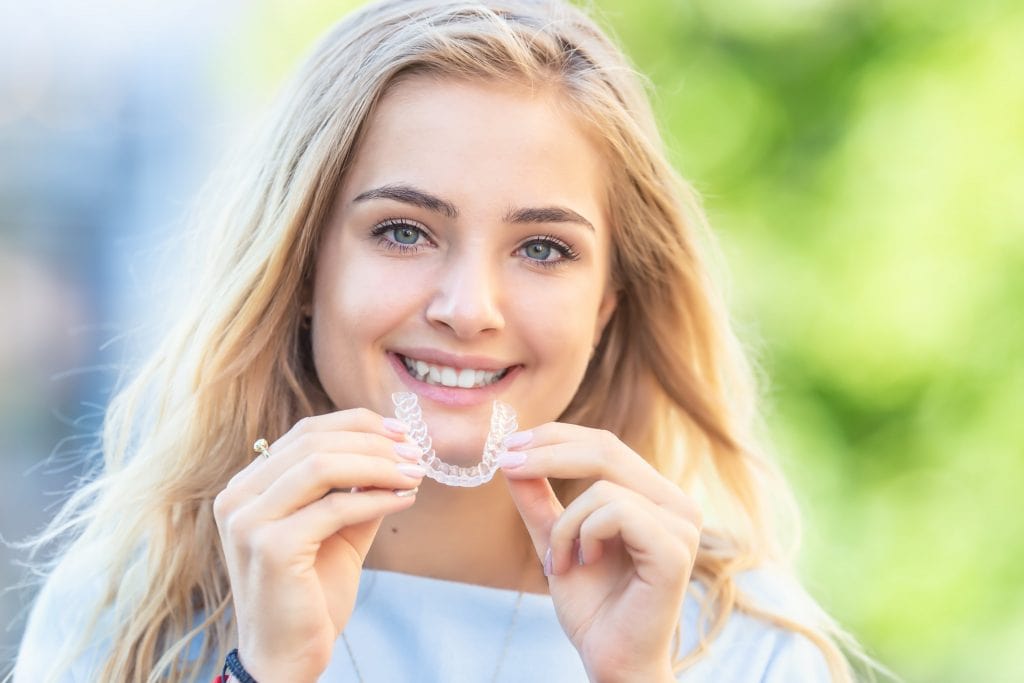The comparison that all of you have been waiting for is right here! Due to the emergency of Invisalign treatment, many patients have been seeking to know the difference between Invisalign and traditional braces. It is a very good question too because you’ll be surprised by some of its comparisons and its differences. Highlighting what these are, alongside reading up on some minor side effects, will hopefully provide you with the knowledge you need to make an informed decision on which works best for your teeth; Invisalign or traditional braces?
Find out here what Invisalign treatment is, and read on below how it compares with traditional braces.

What Are Traditional Braces?
Traditional braces are made of metal, formed with brackets, wires and brackets as a fixed metal appliance to straighten your teeth. Metal braces are an ancient technique that still produces the results patients look for today. The traditional braces are fitted through a wire that’s threaded through individual brackets placed on each tooth. The dentist can place different pressure levels on areas of the bite so that your teeth shift into the desired position.
Traditional braces are a permanent fit, typically for a period of 18 to 24 months, and requires periodic tightening at the dentist every 4 to 6 weeks to apply steady pressure to straighten your teeth. The braces will be permanently fitted for 24 hours a day, even through eating and talking.
The Key Differences
Oral Hygiene
Invisalign – Caring for your aligners is quite simple but requires you to be strict with your oral routine. By this, we mean keeping your mouth clean at all times when wearing the aligners. This includes brushing your teeth twice a day, rinsing your mouth after a meal and avoid using your teeth for anything other than what it’s designed for. There are many ways you can clean your aligners, such as with baking soda, gentle soap, hydrogen peroxide and lukewarm water. Ultimately, ensure both your mouth and the aligners are clean every time you wear them to avoid bacteria being stuck in your teeth. This can cause dental plaque to build.
Traditional Braces – Traditional metal braces are not easy to maintain. This is because food debris tend to get trapped around the brackets and the wires. This can cause a variety of oral issues such as dental plaque build up, cavities and gum disease over time if the debris persists. Here are some tips when brushing your teeth:
- Angle your toothbrush towards the gums to remove any food debris
- Use the angle and brush towards the top of the brackets and brush downwards
- Angle your toothbrush towards the bottom of the brackets and brush upwards
Dietary Tips
Invisalign – The dentist will usually recommend you to avoid sugars and starch foods to keep teeth and gums strong. In reality, when wearing Invisalign aligners, there aren’t exactly any dietary restrictions you need to consider. When eating, simply ensure your mouth is clean at all times before you place the aligners back into your teeth.
Traditional Braces – With traditional metal braces, you need to be careful of the food and drink you consume in the fear that it may catch onto the wires. This can be difficult to remove when brushing your teeth. Avoid hard and sticky foods and limit your intake of fizzy drinks. The acid can dissolve the bonding of the tooth and the bracket.
Dentist Visits
Invisalign – Invisalign requires you to visit the dentist for a check-up after 6 to 8 weeks, unless you have any complications with the aligners.
Traditional Braces – With traditional metal braces, it is likely that you need to visit the dentist for regular check-ups, preferably every 4 to 6 weeks for adjustments. The dentist will also consider performing a professional clean of your teeth. This may mean taking out the wires connecting to the braces or work around them to ensure no food debris is stuck.

The Final Treatment Stages
After the treatment plan of both traditional braces and Invisalign is complete, the dentist will provide you with removable retainers for a period of 3 to 6 months. The dentist may recommend wearing fixed retainers that are only removable when visiting the dentist. Are you wearing Invisalign aligners, read here to learn how to care for them effectively.
Why not get in touch with our experienced team at Marvel Orthodontics who will gladly assist you to transform your smile? Alternatively, you can find out more information on which treatment works better for you, Invisalign or traditional braces? Contact us here and get in touch with us now!

